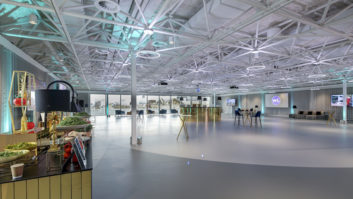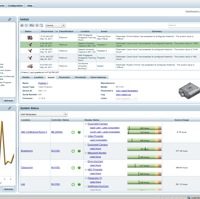
Previously we looked at how green issues are informing customers decisions, here David Davies looks at the role of videoconferencing as well as the importance of manufacturers future-proofing products.
Lifesize CTO Bobby Beckmann highlights packaging as a further aspect of the green AV mix, with the company “forgoing ‘retail packaging’ that isn’t readily recyclable in favour of muted brown cardboard boxes packed with brown craft paper and inscribed with standard black ink, all of which is very easily recyclable. And when styrofoam must be used for packing, we clearly delineate how it can be recycled.”
The company also “makes it a point to proactively follow” the Waste Electrical and Electronic Equipment (WEEE) Directive, ensuring that it sets up and manages contacts to arrange for proper disposal and recycling of any hardware decommissioned by its customers. Beyond that there is the inherent environmentally-friendly potential of the video communications sector of which Lifesize is a part.
In the VC world, confirms Beckmann, “we’re in a unique position in that the more than 1.5 billion minutes of meetings that occur on Lifesize’s cloud videoconferencing service and meeting room systems actually aid customers in being more environmentally-friendly themselves. Less business travel for meetings and more telecommuting leads to less gas consumption, fewer greenhouse gas emissions and a smaller corporate carbon footprint, and also presents the attractive side effect of lowering travel costs. So yes, whilst Lifesize also implements features in our devices that make them greener and [result in a] lower TCO, there’s a much bigger story to tell around our advantage in making companies – and entire industries – greener.”
The contribution that (in Beckmann’s words) “extending the lifespan of the technology” can have on the overall impact of pro AV was echoed by other contributors to this article. For Casio, this translates to an emphasis on developing projectors that are future-proofed with support for standards that are both popular now and expected to be so in the future.
As Casio’s national account manager, Alan Garratt remarks: “With technology moving so rapidly, it’s crucial that we take into account new standards and future-proof our products when designing a new range. One way in which we’re doing this is ensuring our latest projectors support both XGA and WXGA resolution. Although XGA is standard in most schools and businesses using projection today, in a few years’ time we can expect WXGA to overtake and become the new standard. We think end users should be equipped for this without having to buy a new product in a year’s time.”
Specific initiatives
Of course, the extent to which customers adopt green AV solutions en masse will be determined in part by basic awareness of their availability. In this regard, initiatives such as the US Environmental Protection Agency and US Department of Energy-backed Energy Star programme – which provides standardised qualification for energy-efficient products – has been a positive influence on purchasing decisions since it was established in the 1990s. Numerous pro AV manufacturers have since brought Energy Star-related products to market, including Atlona, which introduced its new Gain series of compact, energy-efficient amplifiers in 2018. Both Gain 120 and Gain 60 models incorporate efficient Class D amplifier designs and are Energy Star-qualified.
Increasingly, though, we can expect to see individual companies implement large-scale environmental strategies that cover multiple aspects of production. The efforts announced in April 2019 by Meyer Sound are a case in point. With director of facilities and campus expansion Gary Robinson spearheading the initiative, the company revealed details of a renewed commitment to further reduce energy consumption, cut manufacturing waste to zero, and provide more incentives for employees to reduce their personal carbon footprints.
As Robinson reveals, the company is currently half-way through a five-year plan devised in conjunction with green business practices consultancy REV Sustainability. The refinement of Meyer Sound’s production processes has been a major element of the plan, with achievements to date including: a substantial reduction in lighting-related energy consumption by moving across to LED-based systems; conversion of wood waste from loudspeaker cabinets into pellets for biomass electricity generation or recycling into veneers or gardening mulch; and a total reduction in manufacturing waste of nearly 75%.
Consequently, says Robinson, “no old or rejected electronic components go to landfill. We take an amplifier down to the PC board, stripping and recycling the copper, aluminium and plastic, even the steel screws. And for lunchroom waste, we now have composting bins.”
Meanwhile, in the kind of collaborative initiative that could usefully be adopted more generally by the AV industry, Meyer Sound has also exchanged ideas with other types of business in its home area of San Francisco Bay. “Our group included Pixar Animation Studios and Bayer Pharmaceuticals, which are very different businesses from us. But that actually helps us learn because we benefit from their different perspectives,” says Robinson.
Moving forward it is probable that more and more pro AV vendors will seek to surpass the basic legal or regulatory requirements, making environmental impact a cornerstone of their production, support/after-care and marketing activities. As Farquhar remarks of Exterity, “our objectives are to meet, and where appropriate, exceed all relevant UK, European and international legislative and regulatory requirements and agreements. We consider environmental impacts to be an essential consideration when evaluating new projects, products and operations.”
And increasingly, the impression is that these developments will resonate with the shifting priorities of AV consumers. As Garratt remarks, green AV is a “rapidly growing area of interest while concern for carbon emissions and climate change grows, and sustainability is put at the core of business decisions in all kinds of organisations.”
It is arguable that in terms of mainstream public perceptions, the urgency of our global climate predicament is still yet to fully hit home. But as the number of extreme weather incidents increases and the potential impact on homes and businesses becomes more clear, it is inevitable that consumers – domestic and professional – will wish to invest in products that are energy-efficient and are made and distributed in as eco-friendly a method as possible. Viewed in this context – and with the caveat that there is a still a very long way to go – the pro AV industry is now surely moving in the right direction.
www.casio.com
www.exterity.com
www.lifesize.com
www.meyersound.com






